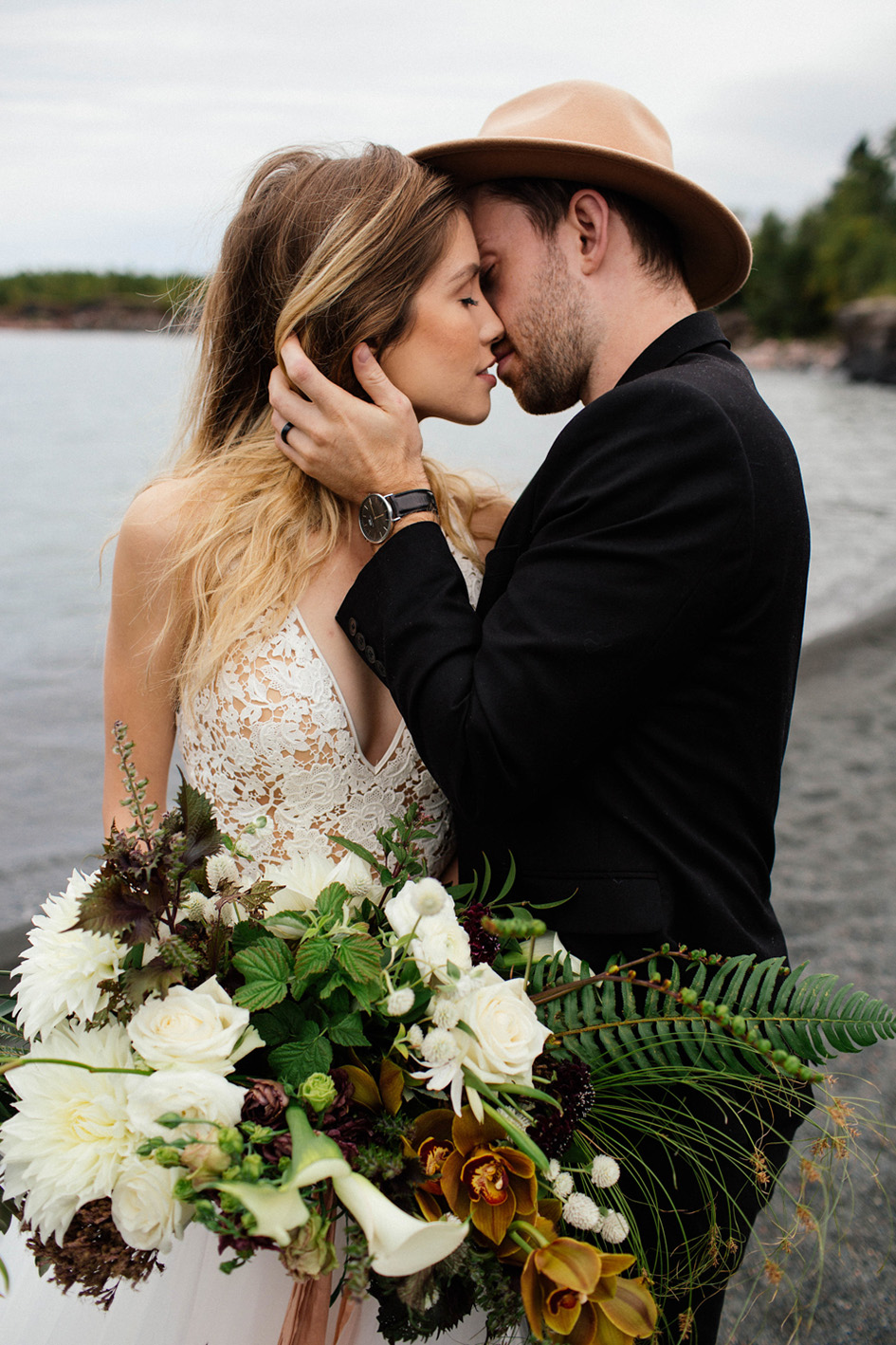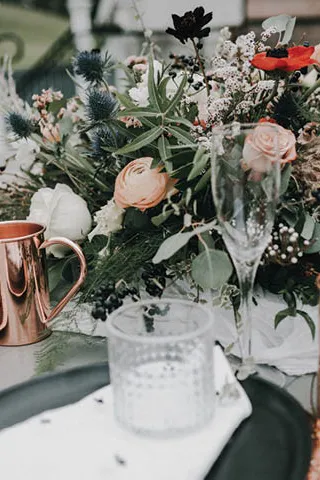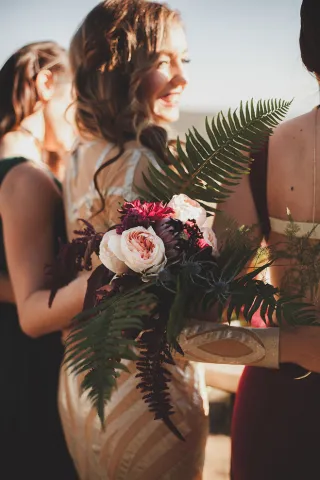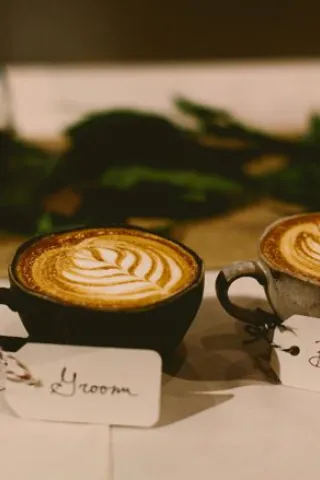When the global pandemic forced couples to change their wedding plans, it didn’t stop them from getting married. Instead, it made many rethink how they would go about it. For some, it meant rescheduling. For others, it meant a quick trip to City Hall, with plans to throw a big party later. But some saw it as the perfect opportunity to pare down and simplify, realizing that what they really wanted was an intimate gathering that didn’t skimp on style but was steeped in meaning. Many brides (and some of their mothers) have dreamed of a big, beautiful wedding with all the trimmings since they were little girls. Though COVID-19 might have dashed some of those dreams, many couples were already considering the merits of these intimate celebrations.
ATTITUDE ADJUSTMENT
Even before social distancing meant size restrictions, Gretchen Culver says she had started to notice that couples were shrinking their guest lists—“from 200-plus to 100 to 80 to 60 ... the smaller wedding trend was something I had been noticing for a while.” It’s a change in the couples themselves, says Culver of Rocket Science Events and Minne Weddings. “They’re creating their own events. This new generation of couples, they don’t value the same sort of wedding experiences that their parents had.” So when COVID-19 hit, she started really exploring small weddings. Minne Weddings, launched in April, offers an all-inclusive wedding package featuring a micro-wedding for 30 or fewer people. The 90-minute event at one of several venues on specific dates includes officiant, flowers, décor, photography and videography, cake and champagne. Some couples who had planned a huge celebration have opted for this Minne Wedding because they don’t want to wait. Others, who have had no set plans, like the convenient one-stop aspect: No need to spend time and energy on details and planning, so they can just focus on their love on the big day. Still others tell Culver, “We’re having the wedding we always wanted—we never really wanted to have a large-scale, traditional wedding in the first place.”
SNAPSHOT OF A SMALL WEDDING
A small wedding gives you the opportunity to put your own stamp on it and share it with your nearest and dearest. Making your wedding day a deeply personal experience for all involved is what makes small so special. Unlike an event with hundreds of guests, you can actually sit down and talk with your friends and family, and they have the chance to get to know each other. A small guest list also means your venue options are almost unlimited. You can hold your ceremony at a place that holds meaning for you as a couple and share it with your loved ones—the bench along a nature trail where you got engaged, the private room of a restaurant where you had your first date, at a favorite lake where the two of you vacationed. Maybe you make a weekend out of it with a destination wedding in an exotic locale or a camping trip at a national park.
With an intimate event, you can make the most of special touches, says Faith Folayan of This Love Weddings; she suggests personalized place settings and menu cards. Instead of long tables and a sit-down dinner, guests can enjoy individual desserts at cozy café-style tables. Instead of elaborate centerpieces, flowers can form a ceremony backdrop or enchant in a hanging installation. Plus, she notes, fewer pieces mean you can invest more in each. If good food, good wine and gathering with good friends is an important part of life, splurge on a gourmet meal in a family-style setting. If casual is more your taste, end the evening around a fireplace or by a fire pit, making s’mores for a late-night snack or going nostalgic with milk and cookies. And no matter how small the wedding—even if you decide to elope—have a photographer on hand to capture the moment. This is part of your story as a couple, and you’ll want to document it for generations to come.
A small wedding doesn’t necessarily mean it will be small in expense, though that might be one consideration. A certain amount of organizing will still be required, especially if you want to arrange for a special venue, organize a meal or reception, plan to hire a florist or engage a rental company. And if planning and execution isn’t something you relish, hiring a professional is a good idea.
VIRTUAL IS ITS OWN REWARD
Another trend is virtual weddings, with the ceremony held online and guests “attending” from the comfort of their own homes. Virtual weddings also allow guests to attend who couldn’t make it otherwise, especially in light of restrictions and precautions some are observing. A virtual wedding can still include traditional aspects—“music, the cake cutting, that first dance moment,” Folayan says, but you can remove other items from the usual “must haves.” (What about the gown? “The dress is definitely not taken off the list!” Folayan says.) Culver also says couples should consider a videographer as well as a photographer, for all the spontaneous moments. If even loved ones can’t attend the wedding, they can see it, for example, on the wedding website—or at the reception the couple holds on their first anniversary.
MARRY NOW, PARTY LATER
Some couples postponed the big spring or summer weddings, but have already rebooked for 2021, hoping that by then the health crisis will have eased and with it, restrictions on group size. Sentimental reasons often figure into picking a certain wedding date, Folayan says. “They want to keep that memorable date, but they’re also being very mindful.” They’ll have the small ceremony, and in a year “they’ll have the big celebration, that moment with family and friends.” Sarah Trotter, owner of Lasting Impressions Weddings, says couples making plans now “are at a great spot because they’re aware of what the limitations might be. Long term, we’re going to see a lot more intimate weddings.” Culver agrees. “This [pandemic] is going to change the way we gather,” she says. “We’re going to gather more intentionally.”
LET’S GET SMALL
Gretchen Culver, Co-Founder of the National Small Wedding Society, explains wedding size.
A mini-wedding—also known as a small wedding or intimate wedding—has fewer than 50 guests, but all the traditional elements, just on a smaller scale. The budget, however, might not be quite so mini. The event requires the same vendors as a large wedding does, with cocktails, a meal, desserts and dancing, though with fewer people to serve and presumably in a smaller space.
A micro-wedding, or tiny wedding, has 30 or fewer guests. It might last only an hour or two—just long enough for a ceremony, followed by drinks and light snacks or cake, a few photos and possibly video. Culver’s company, Minne Weddings, puts together all-inclusive micro-wedding packages that include a venue, a ceremony, cake and champagne, flowers and a photographer. (Add-ons are available.) It’s a great option for couples who are happy to leave all the details to others.
An elopement is when a couple gets married with just an officiant (and the required witnesses, as required depending on locale). There’s nothing traditional about this bare-bones ceremony, but some newlyweds choose to send out “Just Eloped” announcements.
A “minimony” is a new trend, a step up from eloping, with 10 to 20 people attending as the couple exchange vows, but no celebration immediately afterward. Instead, a big party or reception is planned down the road: #marrynowpartylater!
10 TIPS FOR A VIRTUAL WEDDING
Technology now makes it possible to have a small wedding—with hundreds of guests. Just make sure you've made the necessary preparations.
1. Make sure the vows are legal. A commitment ceremony doesn’t count, in the eyes of the law. Check your county’s regulations; In Minnesota, a licensed officiant and two witnesses are required.
2. Decide which platform you’ll use. The videoconferencing app Zoom has been wildly popular for businesses, schools and group gatherings, but there are other online services such as Facebook Messenger, Skype and Google Hangouts.
3. Download and do a practice run with the app before the ceremony. This gives you a chance to work out technical glitches and even switch to another app if you find you’re not comfortable with your first choice.
4. Have your online gathering password protected. Zoom can create a password that is issued to attendees when they are about to join the online gathering. Different apps have different means to set up protection.
5. Let friends and family know that the wedding is on. On screen, that is. Send out evites or per- sonal email messages in advance to alert guests to the time and any technical information they might need. Save the elegant sta- tionery for the big party you throw later or for a fun “We’re married!” announcement.
6. Realize that this technology is still relatively new for many people. Designate someone to play host so you and your officiant don’t have to. That person can remind your guests to mute their devices until asked to join in, perhaps with applause at the end of the ceremony or a toast if you hold a virtual reception. The host can also issue comments and directions through a chat function, and, if they’re on-site, they can even help position the camera for the best angle. Work with your officiant to come up with a timeline or a script.
7. A rehearsal is a must. Check out the lighting at the ceremony site at the scheduled time of day; make sure you’re not hidden in shadows or squinting in sunlight. Set up your space so it’s free of background distractions (or embarrassments). Make sure the sound is clear and no noisy “house sounds” interfere. Try on your wedding-day makeup to see how it looks onscreen and at the distance you will be from the camera.
8. Dress in your wedding finery if you want. And let your guests know if you’d like them to get gussied up for the occasion, too, or if they can attend in their sweatpants.
9. Allow time for guests to chat online. Be sure they know, however, they can’t all talk at once because of technical limitations. Set protocol if necessary, or encourage using the chat function if it’s a conversation among only a few people and not the entire group.
10. It doesn’t have to stop right after the vows. There’s no reason not to cut the cake onscreen, or show off a couple of dance moves. Again, practice in advance so your guests aren’t looking at the ceiling instead of the main event: you.
MAKE YOUR WEDDING UNIQUELY YOURS
You've decided to go small, so you can make the day ultra-personal. Here are a few ideas:
» Instead of a traditional white or ivory gown, choose a dress in your favorite color.
» Not into cake? Serve pie, doughnuts, cotton candy or ice cream sandwiches.
» Customize a beverage, dessert or ice cream flavor.
» Have a roving photographer with a Polaroid camera take pictures during the reception and compile an on-the-spot scrapbook.
» Ask friends to share a memory, a prayer or a wish during the ceremony.
» Use exquisite china, crystal and linens.
» Write a personal note for each guest to leave with their name card or at their place setting.
» Ask friends to bring flowers from their garden to be part of a special arrangement.
» Compile a list or a small booklet of the special details you’d like to share with your guests: Where your flowers came from, who made your cake, what makes your photographer awesome, why the venue—or the music, the date or food—has special meaning, the story of how you met, what the proposal was like.
» Provide special entertainment: a singer, a dance performance, a magician.















